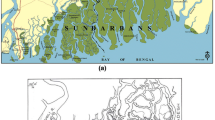Abstract
A very severe cyclonic storm ‘Thane’ developed over the Bay of Bengal during 25–30 December 2011, crossed the Tamilnadu coast between Pondicherry and Cuddalore (southeast coast of India) in early hours of 30 December with a wind speed 120–140 km/h. The offshore tide record reveals that the surge started to generate around 1100 hours on 29 December 2011 with a height 0.4 m and later raised to 0.68 m at the time of land fall, that is, early hours (0000 hours) of 30 December 2011. Field reconnaissance survey on surge run-up and inundation distance at 15 selected locations of cyclone affected areas reveals that the vulnerability levels are highly variable along the coast. The inundation distance extended up to 30–230 m landward from the shoreline and run-up reached to 1.6–3.2 m above chart datum depending upon the cross-shore geometry of the location. In the areas (Verranampattinam, Chinamudaliyar kuppam and Silver beach) near cyclone landfall, the run-up was up to 2.5–3.2 m and the inundation distance extended up to a maximum of 230 m. However, in the areas located about 150 km north of cyclone landfall, the run-up limited from 1.6 to 1.7 m and the inundation distance extended up to only a maximum of 169 m. The inundation distance is mainly influenced by the slope of the beach. In the areas having beach slope between 1 in 135 and 1 in 220, the inundation distance was 210–230 m. However, in the areas having beach slope 1 in 17 to 1 in 34, the inundation distance is restricted between 35 and 50 m.






Similar content being viewed by others
References
Chen Q, Wang L, Tawes R (2008) Hydrodynamic response of northeastern Gulf of Mexico to hurricanes. Estuaries Coasts 31:1098–1116
Flather RA (2001) Storm surges. In: Steele J, Thorpe S, Turekian K (eds) Encyclopedia of ocean sciences. Academic, San Diego, pp 2882–2892
Fritz HM, Blount C, Sokoloski R, Singleton J, Fuggle A, Brian G, McAdoo MA, Grass C, Tate B (2007) Hurricane Katrina storm surge distribution and field observations on the Mississippi Barrier Islands. Estuar Coast Shelf Sci 4:1–9
Harris DL (1957) The effect of a moving pressure disturbance on the water level in a lake. Meteorol Monogr 2:46–57
Harris DL (1963) Characteristics of the hurricane storm surge. Technical Paper no. 48, U.S. Department of Commerce, Washington
Hartnett JJ (2011) Coastal inundation due to storm surge as sea level changes along the northern South Carolina and southern North Carolina coast. http://www.coastal.edu/honors/theses/2011/Hartnett.J.pdf
IIT-M (Indian Institute of Technology-Madras) (2011) Assessment of functional performance of coastal structures along East Coast of India. R & D Project, Ministry of Earth Sciences, Government of India, Interim Progress Report, pp 10–11
IMD (India Meteorological Department) (2011a) Very severe cyclonic storm “THANE” over the Bay of Bengal (25–31 Dec 2011). Ministry of Earth Sciences, Government of India, Cyclone Warning Division, New Delhi
IMD (India Meteorological Department) (2011b) Special tropical weather outlook for the north Indian Ocean (26 Dec 2011). Regional Specialised Meteorological Centre, New Delhi
Jeffrey M (2012) Director of Meteorology, Weather Underground, Inc. http://weather.royalgazette.com/auto/royalgazette/hurricane/surge_characteristics.asp. Accessed on 7 Mar 2012
Jossy PM, Mahadevan R (1996) Numerical simulation of open coast surges—part II. Experiments with storm parameters and shelf geometry. J Coast Res 12:123–132
Rappaport EN, Fernandez-Partagas JJ (1995) The deadliest Atlantic tropical cyclones, 1492–1994. NOAA Technical Memorandum NWS NHC-47, National Hurricane Center
Redfield AC, Miller AR (1957) Water levels accompanying Atlantic coast hurricanes. Meteorol Monogr 2:1–23
USACE (U.S. Army, Corps of Engineers) (1939) Supplemental report on hurricane of September 21, 1938, and its effect on the coastal region, U.S. Engineer Office
Wtvy (2012) Storm surge. http://www.wtvy.com/weather/hurricane/misc/19486729.html. Accessed on 14 Febr 2012
Acknowledgments
The authors wish to express their sincere thanks to Dr. Shailesh Nayak, Secretary, Ministry of Earth Sciences, Government of India for his keen interest and encouragement. They express their gratitude to IMD, Chennai, for providing the report on Thane cyclone and also to INCOIS for providing some of the tide data make available for the present work.
Author information
Authors and Affiliations
Corresponding author
Rights and permissions
About this article
Cite this article
Rao, V.R., Subramanian, B.R., Mohan, R. et al. Storm surge vulnerability along Chennai–Cuddalore coast due to a severe cyclone THANE. Nat Hazards 68, 453–465 (2013). https://doi.org/10.1007/s11069-013-0630-1
Received:
Accepted:
Published:
Issue Date:
DOI: https://doi.org/10.1007/s11069-013-0630-1




